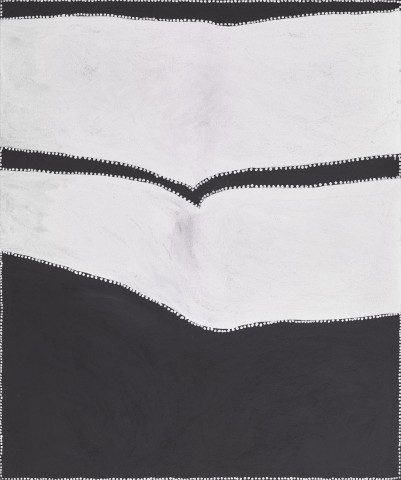CAMEL GAP, 2001
PADDY NYUNKUNY BEDFORD
ochres and pigments with synthetic binder on linen
180.0 x 150.0 cm
signed with initials verso: PB
Jirrawun Arts, Kununurra, Western Australia (cat. PB 3-2001-97)
RAFT Artspace, Darwin
Private collection, Darwin, acquired from the above in 2002
Four Men, Four Paintings, RAFT Artspace, Darwin, March 2001 (as ‘Goanna Dreaming – Camel Gap’)
Paddy Bedford, Museum of Contemporary Art, Sydney, 6 December 2006 – 15 April 2007, then touring to: Art Gallery of Western Australia, Perth, 12 May – 22 July 2007; Bendigo Art Gallery, Victoria, 11 August – 16 September 2007; University Art Museum, University of Queensland, Brisbane, 16 November 2007 – 1 March 2008
Storer, R., Paddy Bedford, Museum of Contemporary Art, Sydney, 2006, pp. 36 (illus.), 37, 149 (illus.)
From the time he first began painting on canvas in 1998, it took less than a decade for Paddy Bedford to be one of the most sought-after contemporary artists in Australia’s metropolitan galleries with collectors and museum curators keenly chasing his works at commercial exhibitions in East coast capitals. Like many of the first generation of contemporary indigenous artists, Paddy Bedford had lived a long and eventful life before taking up a brush to apply pigments and ochres to a stretched canvas of Belgian linen. As Michael Dolk comments in his introduction to the 2007 retrospective catalogue for the Museum of Contemporary Art, Sydney ‘Paddy Bedford’s paintings articulate a complex dialectic between modern materials and traditional pictorial conventions, contemporary experience and ancient belief systems’.1
Bedford painted with a deep sense of history and cultural responsibility, using stories from his father’s country, or his mother’s and uncle’s country. Bedford explored the rich history of the east Kimberley and the important stories that have mapped its past, painting the bones of the landscape with the waterholes, stockyards and roads that he traversed all his life. Within his canvases, historical events and more mundane stories about daily life on cattle stations co-exist creating a body of work with profound and lyrical knowledge of the land and its creation stories. Camel Gap, 2001 documents an evolution in his painting style and characterises Bedford's link between the more familiar style of the earlier East Kimberley painters and his own innovative changes in style and technique in representations of country.
Camel Gap is a story from the artist’s mother’s traditional lands that illustrates the shared recent history of Gija and non-Aboriginal people. Known as Gernawarliyan to the local Gija people, it is located to the south-east of Bedford Downs adjacent to Marty’s bore, a few kilometres east of the Springvale – Lansdowne Road. It is connected to a ngarranggarni (Dreamtime) story of the goanna Garndoowoolany who camped here. Garndoowoolany called out to Marranyi, the dingo, who he saw at the top of the hill. It was here that Marranyi got stuck and became part of the rock. Its English name refers to the shape of the hill and also to the Afghan cameleers who, in the early twentieth century, travelled past this place on their journey south from the port at Wyndham to remote Kimberley communities and further afield for trade.
Until the time of his passing in 2007, Bedford continued to experiment with form and pictorial convention, his use of wet-on-wet painting techniques and gestural mark making elevated his work to new heights of contemporary expression. With his dramatic monochromatic contrasts and hints of pure figuration, his simple, minimalist approach was in stark contrast to the more recognised desert (dot) paintings that had become so-well known before the advent of the Jirrawun movement.
1.Storer, R., ‘Paddy Bedford’ in Michael, L., Paddy Bedford, Museum of Contemporary Art, Sydney 2006, p. 11
CRISPIN GUTTERIDGE
